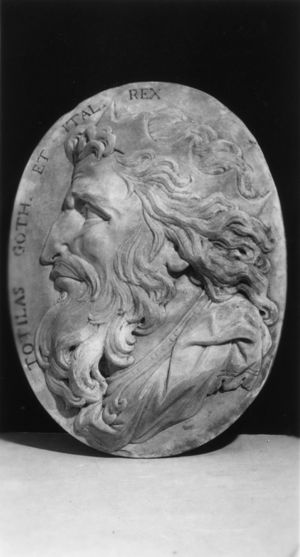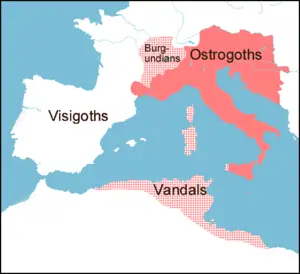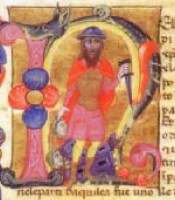How Was Totila Able to Sack Rome in AD 546
Rome is generally viewed as not just one of the greatest cities of the ancient world, but one of the greatest cities of all time. For most of its early history, Rome was as safe as it was prosperous and cultured. It was threatened on numerous occasions by several different armies, but was only sacked three times between the inception of the Roman Republic in 509 BC and the Gothic War of the sixth century AD. The Gauls were the first non-Romans who were able to successfully breach the city’s walls in 390 BC, which led to the Romans taking more proactive measures to defend their city. During Rome’s long, steady decline, it was sacked several more times – in AD 410 by the Visigoths, then less than fifty years later in 455 by the Vandals, and finally in 546 by the Ostrogoths.
Although the Ostrogoth sacking of Rome in 546 was less spectacular than the previous cases, it was just important in terms of the post-Roman political composition of Europe. The Ostrogoths had conquered Italy in the late fifth century, effectively ending any pretense that “Rome” still existed in western Europe. The Ostrogoths, though, were challenged by the nascent Byzantine Empire in Constantinople, whose emperors saw themselves as the true heirs of the Roman Empire. During the middle of the sixth century, the Ostrogoths and Byzantines fought for control of Italy in the “Gothic War” and as a result the city of Rome, which was by that time more of a symbolic rather than a strategic target, was captured numerous times by both armies. The most daring siege and subsequent sacking of Rome during the Gothic War was led by the Ostrogoth King Totila, who used a combination of patience and guile to take the city.
Contents
The Ostrogoths in Italy
The Ostrogoths were one of the many Germanic tribes that began flooding into the limes of the Roman Empire beginning in the third century AD. By the time the last Roman emperor in the west abdicated in AD 476, the Germanic tribes had already established semi-autonomous kingdoms throughout western Europe while the Byzantine Empire ruled over southeastern Europe, Anatolia, and parts of the Near East. The Ostrogoths became a major player in European geo-politics when they settled in the region of Pannonia in 454 and became a federated tribe under the Eastern Emperor Marcian (ruled 450-457), which was also around the time when Theodoric (reigned ca. 471-526), who would become king of the Ostrogoths and ruler of Italy, was born. [1]
During his youth, as was common in pre-modern times, Theodoric lived as a hostage in Constantinople where he learned Greek, Latin, and the arts of diplomacy and war from his Byzantine benefactors. Once Theodoric reached manhood at around age sixteen or seventeen, he returned to Italy where he was elected king of the Ostrogoths. [2]
Theodoric was not content with just being the king of the Ostrogoths, though, so in 488 he embarked on a campaign to wrest all of Italy away from another German named Odovacar. The connections Theodoric cultivated in Constantinople proved fruitful when the Byzantine Emperor Zeno (ruled 474-475 and 476-491) refused to support Odovacar, which put him in an untenable situation. [3]
The war between Theodoric and Odovacar finally ended when the Visigoths joined the Ostrogoths in an alliance in 490. Although Theodoric and Odovacar negotiated a peace treaty, Theodoric decided to kill Odovacar anyway. On March 15, 493, Theodoric personally hacked Odovacar to death, reportedly stating something to the effect that his adversary “had no backbone.” [4] With that act of violence, Theodoric instituted a new Ostrogoth dynasty that ruled Italy, ushering in some fundamental changes. Although Theodoric and the Ostrogoth nobility for the most part respected Roman culture, they were still destined to clash with the Byzantine Empire.
The Gothic War (535-554)
The relationship between the Ostrogoths and the Byzantine Empire was for the most part amicable, with most of the Ostrogoth rulers accepting their subordinate position to Constantinople. Still, the presence of a large Ostrogoth army in Italy was concerning to the Byzantine Emperor Justinian I (ruled 527-565), who desired to rule over all the lands of the former Roman Empire. The situation in Italy became chaotic in 535 when the queen regent, Amalasuintha, was murdered by her cousin and co-regent Theodahad (reigned 534-536). The assassination gave Justinian I the casus belli to invade Italy. [5]
The result of the war for Rome and Italy was catastrophic. Rome was plundered five different times, which was the result of three sieges, two by Totila. Some parts of Italy were subjected to such widespread destruction that it took centuries to rebuild – Milan and Naples were especially hit hard when they were subjected to sieges and sacked. [6] But none of the sieges and sackings during the Gothic War were more important than Totila’s sacking of Rome in 546.
Totila’s Siege
Totila (ruled the Ostrogoths 541-552) was a true Ostrogoth in every sense of the word. Although he valued the art of diplomacy, Totila knew that in order to satisfy the Ostrogoths he would have to take a more bellicose stance toward the Byzantine Empire, which ultimately proved to be successful for his military and political career. Since he was not of the Amali Dynasty started by Theodoric, Totila had no apparent chance to be the king of the Ostrogoths, but he was able to take advantage in a lull in the hostilities during the Gothic War. The more traditional, war-like Ostrogoths wanted to keep fighting the Byzantines so they elected Totila, who was the commander of the Ostrogoth army, to be their king in the belief that he would restart the war with Justinian. [7]
Once he was crowned king, Totila played the long game against his Byzantine foes. Instead of sending the bulk of his army into head-on confrontations, Totila showed patience by ambushing smaller Byzantine detachments and by employing long-range sieges instead of attacking city walls directly. [8] Totila’s early, modest successes were enough to raise the spirit of the Ostrogoths – he was able to raise an army of 5,000 men in the winter of 541/42 that fought its way to victory that spring in the city of Faenza against a superior Byzantine force. [9]
After a series of victories, Totila turned his eyes to the symbolic target of Rome. Although Rome’s political importance had been lost in the previous centuries to Constantinople and Ravenna, it still inspired a certain amount of awe and reverence among the Ostrogoths and Byzantines alike, so whoever controlled the city could boast of a moral victory. In late 545, Totila led the Ostrogoth army to the gates of Rome, but instead of directly attacking the walls as his predecessors had done, he laid siege to the city by surrounding it. Although there was a small Byzantine garrison guarding the city, Totila negotiated with the non-military Roman natives for a surrender. Totila told the Romans that the siege would not end unless they unequivocally met his three conditions: the walls must come down, no quarter would be given to the Sicilians, and all the Goth slaves would be released. [10] The Ostrogoth king knew that the demands would be too much to accept, so he wisely secured his flank by enacting an alliance with the Franks to the north. [11] Totila was then free to put his plan into action.
Just before Christmas, on December 17, 546, Totila’s sacking of Rome began. It was actually quite anti-climatic compared to the previous sackings of Rome and involved more guile than brute force. Totila was aided by the fact that Besssas, the commander of the Byzantine garrison in Rome, was woefully unprepared as he neglected the city’s defenses. The Ostrogoths were then able to bribe some of the gate keepers who had no real allegiance to Rome as they were ethnic Isaurians. After some negotiating, the Isaurians agreed to led the Ostrogoths into the city’s gates. The sixth century Byzantine historian, Procopius, wrote:
“Totila, then, as soon as night came on, put his whole force under arms in silence and led them up near the Asinarian Gate. And he commanded four men who were conspicuous among the Goths for their bravery and strength to climb up the ropes with the Isaurians to the battlements, during that part of the night, of course, in which the guarding of that portion of the wall fell to the Isaurians while the others were taking their turn at sleeping. And when these men got inside the fortifications, they descended to the Asinarian Gate without meeting any opposition; there they shattered with axes both the wooden beam with which the Romans customarily made the gates fast by fitting it into recesses in the wall on either side, and also all the ironwork into which the guards always inserted their keys to shut the gates or open them according to the need of the moment. Then they swung the gates open, just as they wished to do, and without any trouble received Totila and the Gothic army into the city.” [12]
Because he was a Christian, Totila forbade his men from committing any widespread pillaging once inside the city walls, which resulted in an extremely low causality count according to Procopius. [13] Totila then tried to make peace with Justinian, but when he realized the Byzantine Emperor did not want to negotiate, he destroyed much of Rome’s walls and left the city. [14] Totila tried to take Rome again later that year but failed and moved on to other parts of Italy. [15]
Conclusion
Although Totila was killed in battle and the Ostrogoths eventually lost the war to the Byzantine Empire, it was somewhat of a pyrrhic victory for Justinian I and Rome. All of Italy was devastated with large swathes of it needing several decades to recover. Rome in particular suffered from a population decline and the Senate was never again mentioned in the city records. [16] After defeating Totila and the Ostrogoths, Justinian I was able to rightfully claim that the reconquered most of the Roman Empire, but the gains were ephemeral as his successors steadily lost the possessions.
Totila would go on to have somewhat of a mixed legacy among Europeans, being revered by many Germans and Italians in the modern period, but sometimes being viewed as a boogey man in medieval times. Despite what some later Europeans may have thought of him, there is no doubt that Totila affected the course of European history when he led the Ostrogoth war against the Byzantine Empire. The Ostrogoth king and military commander was able to sack Rome in 546 by employing a combination of patience and guile and by taking advantage of a historical situation whereby Rome was at one of its lowest points in history.
References
- ↑ Bury, J.B. The Invasion of Europe by the Barbarians. (New York: W.W. Norton, 1967), p. 178
- ↑ Bury, p. 178
- ↑ Sinnigen, William G, and Arthur E. R. Boak. The History of Rome to A.D. 565. 6th ed. (New York: Macmillan, 1977), p. 460
- ↑ Burns, Thomas S. A History of the Ostrogoths. (Bloomington, Indiana: Indiana University Press, 1984), p. 72
- ↑ Burns, p. 204
- ↑ Burns, pgs. 206-10
- ↑ Wolfram, Herwig. History of the Goths. Revised Edition. Translated by Thomas J. Dunlap. (Los Angeles: University of California Press, 1988), p. 353
- ↑ Burns, p. 23
- ↑ Wolfram, p. 354
- ↑ Procopius of Caesarea. History of the Wars. Translated by H.B. Dewing. (London: William Heinemann, 1916), Book VI, xvi, 15
- ↑ Wolfram, p. 355
- ↑ Procopius, VII, xx, 14-15
- ↑ Procopius, VII, xx, 22-25
- ↑ Burns, p. 210
- ↑ Wolfram, p. 357
- ↑ Moorhead, John. “Totila the Revolutionary.” Zeitschrift für alte Geschichte 49 (2000) p. 83



